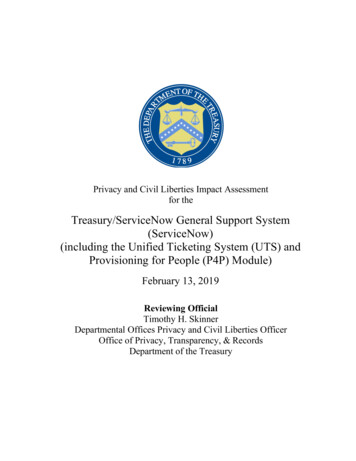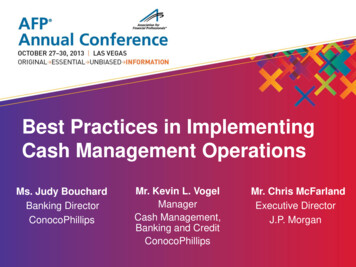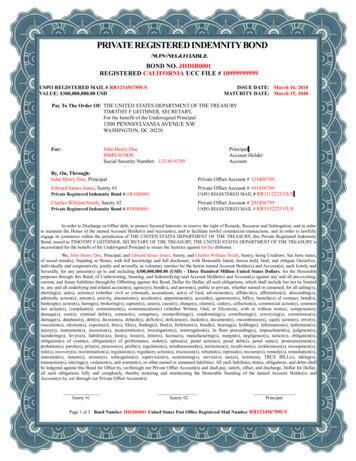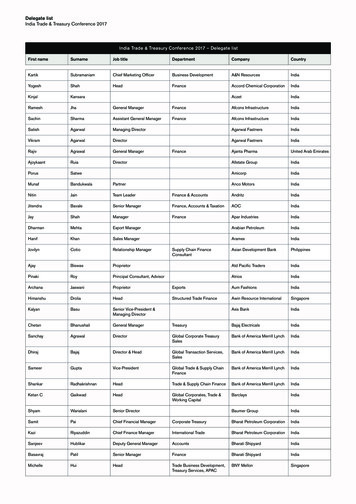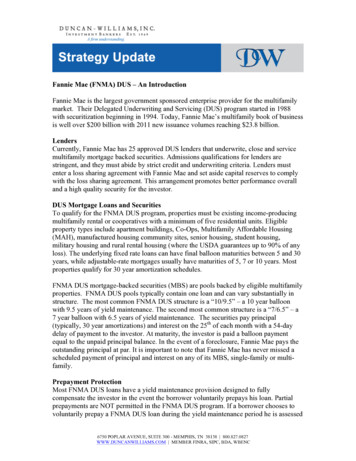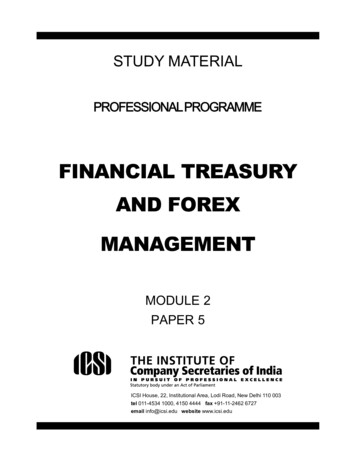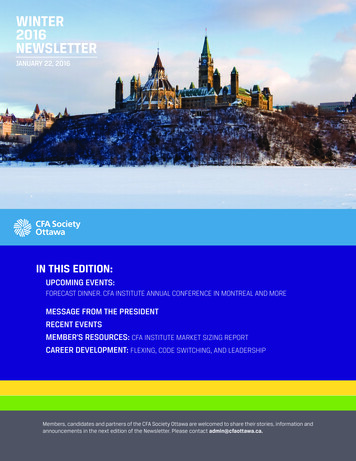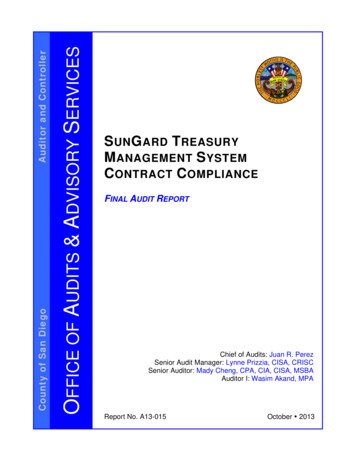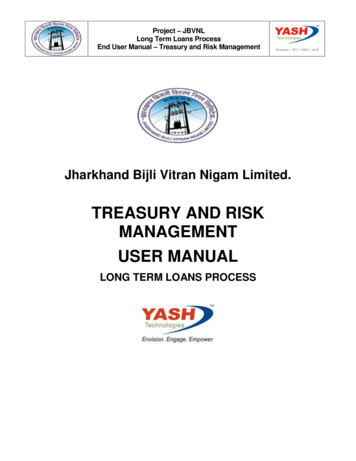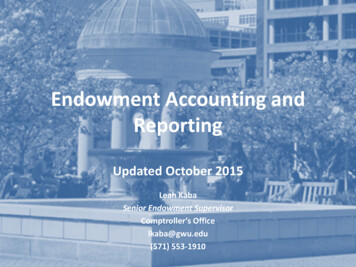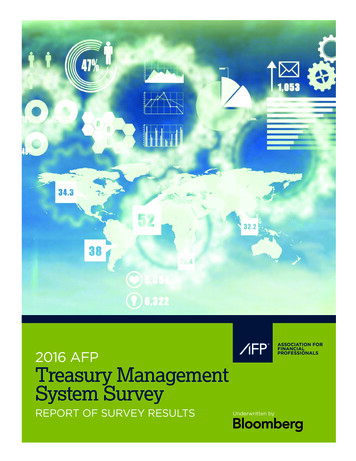
Transcription
2016 AFPTreasury ManagementSystem SurveyREPORT OF SURVEY RESULTSUnderwritten by
KEY FINDINGS2016 AFPTreasury ManagementSystem SurveyUnderwritten by77% of organizations that utilize a Treasury ManagementSystem (TMS) have had their systems for at least three years.201320142015A majority currently use the most recent version of the TMS.STRUCTURE OF ORGANIZATIONS’ TREASURY MANAGEMENT SYSTEMS53% Installed SystemsDelivered as27% Software-as-a-Service (SaaS)20% Module within ERP System
2016 AFPTreasury ManagementSystem SurveyREPORT OF SURVEY RESULTSApril 2016Underwritten byAssociation for Financial Professionals4520 East-West Highway, Suite 750Bethesda, MD 20814Phone 301.907.2862Fax 301.907.2864www.AFPonline.org
Increasingly, Treasury departments are being asked to do more with less in today’sevolving and fast-paced business environment. They must perform risk managementand hedging, manage complex derivative accounting and satisfy increasingly onerousregulatory reporting regimes – all of this on top of the cash and liquidity managementTreasury departments have historically been responsible for. Simply put, Treasurers mustfulfill a more strategic role for their businesses.Given this background, Bloomberg is pleased to once again partner with AFP to producethe 2016 AFP Treasury Management System Survey. More than 350 organizationsrepresenting a strong cross section of size and region responded to this survey withslightly more than half reporting they are using a Treasury Management System (TMS).More European companies (63 percent) use a TMS compared to organizations in NorthAmerica (40 percent) and the Asia-Pacific region (60 percent). More than 71 percent ofcompanies with a TMS said their cash visibility was good to very good, demonstratingthat using a TMS automates processes, improves cash visibility, and enables the Treasurydepartment to spend more time on decisions that increase value to the firm. And, morethan half of the companies with a TMS said the greatest single benefit is either moreefficiency or that Treasury is able to do more with less. With a TMS, Treasury can spendmore time on analysis, increase controllership, and fulfill its mandate to be more strategic.These benefits have been lost on smaller firms, however. The survey found thatcorporations with less than 1 billion in revenue are less likely to be using a TMSbecause the benefits of using one aren’t worth the fees, implementation burden andother costs. Instead, they continue to rely on spreadsheets for core treasury functions suchas forecasting, cash visibility and bank account management. As smaller companies getpast the growing pains around establishing their treasury structure and scope, their needfor technology and automation increases as they grow larger. The research in this guideshows the tremendous opportunity for smaller Treasury departments to leveragetechnology to improve performance.A strong TMS system can enable Treasury departments to focus on analysis, increasecontrollership and add value to the firm. As Treasury departments are tasked with doingmore with less, technology and automation fill the gap. Companies that future-proof theirtreasury departments with the right technology provide a roadmap for success, betterworking capital management, and are able to be more proactive in a business climate thatis often volatile and ever changing. If you’d like to discuss this research or learn moreabout Bloomberg’s TMS, please contact us at bbg trm@bloomberg.net or visit us atBloomberg.com/TRM.
2016 AFP Treasury Management System SurveyIntroductionOrganizations’ treasury departments are responsible for a variety of traditionalfunctions, including account reconciliation, debt and investment management,general ledger posting, foreign exchange (FX) management and balance reporting.But today they are also tasked with managing more complex functions such ashedge accounting as well as specialized reporting to meet changes in governmentregulations. Treasury departments use numerous tools to perform these functionseffectively and efficiently. One such tool is Treasury Management System (TMS)—also known as treasury workstations (TWS). TMS are usually automated systemsor software packages that allow companies and their treasury departments tocommunicate and/or interface with banking partners, vendors and customers inreal time.While a small majority of organizations is using TMS, there is a still a significantshare of companies that have yet to adopt their use. While TMS do streamlineprocesses and operations for organizations, there are still challenges associatedwith TMS. The cost of such systems and the resource constraints surroundingIT support for implementation and maintenance of them are two major reasonswhy companies are hesitant to adopt TMS. Additionally, some organizations areutilizing home-grown solutions while others are using a combination of Excel andonline bank portals.In order to examine trends in the use of treasury management systems, theirstructure and the complexity of the instruments transacted within them, theAssociation for Financial Professionals (AFP) conducted a survey of corporatepractitioners in February 2016. The 354 responses received were analyzed and theresults are presented in this, the 2016 AFP Treasury Management System SurveyReport. The survey results and analysis reveal the current benefits of TMS, thechallenges they present and opportunities for improvement. Results were comparedacross defined regions (based on organization location) and revenue categories.AFP thanks Bloomberg for its underwriting support of the 2016 AFP TreasuryManagement System Survey. The Research Department of AFP designed andimplemented the survey questionnaire and analyzed the results. AFP is solelyresponsible for the content of this report. 2016 Association for Financial Professionals, Inc. All Rights Reservedwww.AFPonline.org1
2016 AFP Treasury Management System SurveyPrevalence of Treasury Management SystemsSlightly more than half (51 percent) of organizations use a treasury managementsystem (TMS), a smaller share than the 58 percent reported in last year’s 2015AFP Treasury Management System Survey Report. Among those with a TMS, thepercentage of companies that have built their own systems is unchanged fromlast year.There are differences in the prevalence of TMS usage based on an organization’s51% of organizationsuse a treasurymanagement system(TMS)location. The use of a TMS is more common among companies located inEurope (63 percent) and Asia (60 percent) than those in North America(39 percent). A larger share of companies based in Asia Pacific than in otherregions use systems that they build themselves.The use of a TMS is often determined by company structure. Organizationsthat have regional installations with shared-service centers or multinationalorganizations with greater need for global applications are more likely to adopt aTMS than are other companies, as they need higher levels of technology.Prevalence of Treasury Management Systems(Percentage Distribution of Organizations)Yes43%49%Yes, we built our own systemNo8%Prevalence of Treasury Management Systems(Percentage Distribution of Organizations)YesYes, we built our own systemNo2www.AFPonline.orgAllNorth AmericaEuropeAsia Pacific43%33%56%44%8671649603740 2016 Association for Financial Professionals, Inc. All Rights Reserved
2016 AFP Treasury Management System SurveyThere are also differences in TMS usage based on size as measured by a company’sannual revenue. Larger organizations—those with annual revenues of at least 1billion—are far more likely than smaller companies (with annual revenues of lessthan 1 billion) to utilize a TMS. Nearly 80 percent of respondents from companieswith annual revenues of at least 10 billion report using a TMS. In contrast, only18 percent of companies with annual revenues of less than 250 million use a TMS.Since larger organizations are more likely to be globally focused, they enlist thesupport of treasury technology so their treasury departments can do more with less;technology enables more economies of scale and scope in their applications.Prevalence of Treasury Management Systems(Percentage Distribution of Organizations)YesAllAnnual RevenueLess Than 250 MillionAnnual Revenue 250-999 MillionAnnual Revenue 1-9.9 BillionAnnual RevenueAt Least 10 Billion43%13%44%56%74%775483721Yes, we built our own system85No4982Structure of Organization’s TMSTreasury management systems are available in a variety of forms. It could be aninstalled TMS, a system delivered as “software-as-a-service”—SaaS/ASP—Of those organizationspurchased from a bank or another vendor, or a module within an enterprise resourcethat have a TMS, 53%planning (ERP) system.use an installed systemOf those organizations that have a TMS, 53 percent use an installed system. Thisshare is very similar to the 54 percent reported in last year’s survey. Twenty-sevenpercent of TMS are delivered as a SaaS/ASP, a lower share than the 33 percentreported in the 2015 survey. Twenty percent of such systems are modules within anorganization’s TMS system—seven percentage points greater than last year’s figure.There are advantages to each of these TMS structures depending on the requirements of an organization’s treasury department and its tasks. Often a treasurydepartment’s needs are very specific and require a customized approach; thus, aninstalled or in-house built system may be the best TMS choice. Today’s SaaS/ASPsolutions are more robust than they were in the past; they offer greater functionalities and have the advantage of being IT “resource-light” (i.e., require limited ITsupport). Indeed, SaaS/ASP offerings are examples of “off-the-shelf” solutions thathave worked well for many treasury departments. Other companies utilize their ERPmodule for Treasury. This could be the result of a corporate mandate to move to anERP installation; Treasury receives the module as part of the process. (This approach also provides a business case to make at the corporate level when requestingany expenditure for the system.) The functionality of ERP modules is not as robust,yet serves departments well in core treasury activities. 2016 Association for Financial Professionals, Inc. All Rights Reservedwww.AFPonline.org3
2016 AFP Treasury Management System SurveyStructure of Organization’s Treasury Management System(Percentage Distribution of Organizations Using Treasury Management Systems)20%Installed53%Delivered as software-as-a-service (SaaS)/ASPModule within ERP system27%Companies based in Europe (66 percent) and those in Asia-Pacific (51 percent) aremore likely to use an installed TMS than are their counterparts in North America(39 percent). North American companies are more likely to have their TMS deliveredas software-as-a-service (SaaS)/ASP than are organizations located in other regions.Structure of Organization’s Treasury Management System(Percentage Distribution of Organizations Using Treasury Management Systems)AllNorth AmericaEuropeAsia Pacific53%39%66%51%Delivered as software-as-a-service (SaaS)/ASP27392123Module within ERP system20211326InstalledOver two-thirds of organizations with annual revenues of at least 10 billion useinstalled systems while about half of companies with annual revenues rangingbetween 250 million and 9.9 billion use an installed TMS. Only 35 percent ofrespondents from smaller companies with annual revenues less than 250 millionreport using installed TMS, suggesting that these smaller organizations are morelikely to use a module within an ERP system.Structure of Organization’s Treasury Management System(Percentage Distribution of Organizations Using Treasury Management Systems)Annual RevenueLess Than 250 MillionAnnual Revenue 250-999 MillionAnnual Revenue 1-9.9 BillionAnnual RevenueAt Least 10 Billion35%56%52%68%Delivered as software-as-a-service (SaaS)/ASP2729303119Module within ERP system20351713AllInstalled53%4www.AFPonline.org15 2016 Association for Financial Professionals, Inc. All Rights Reserved
2016 AFP Treasury Management System SurveyTMS Years Installed and Version in UseThree-quarters of organizations that utilize a TMS have had their systems for at leastthree years. More than 40 percent of them have had their current TMS in place forover five years; 27 percent have been using the same system for over eight years.Organizations in Europe and Asia are more likely to have been using their TMS forlonger periods of time than are their North American counterparts. Forty-five percentof large organizations with annual revenues of at least 10 billion have had their3/4 of organizationsthat utilize a TMS havehad their systems forat least three yearscurrent TMS in place for over eight years, nearly twice the percentage of smallerorganizations (annual revenues of less than 250 million).Number of Years the Current Treasury Management System Has Been Used(Percentage Distribution of Organizations Using Treasury Management Systems)6%Still implementing4%27%13%Less than 1 year1-2 years3-5 years15%35%6-8 yearsMore than 8 yearsFinance professionals make efforts to ensure that their companies are using themost recent version of their TMS. Currently, 54 percent of companies that have aTMS use the most recent version while 33 percent use systems that are one to twoiterations behind the current version. These results are comparable to those reported54% of organizationswith a TMS currently usethe most recent versionin the 2015 AFP Treasury Management System Survey Report. 2016 Association for Financial Professionals, Inc. All Rights Reservedwww.AFPonline.org5
2016 AFP Treasury Management System SurveyCompanies located in North America (58 percent) and those in Europe(56 percent) are more likely than those based in Asia Pacific (44 percent) tobe using the most up-to-date version of their TMS. However, it should be notedthat an equal share of companies in Asia Pacific are using systems one to twoiterations behind the current system. A significant share of organizations withannual revenues of at least 250 million is using TMS which is either current orjust one to two iterations behind the current version.ERP Treasury modules and installed versions include maintenance updatesas new versions are created to comply with changes in the industry (regulatory)or as new requested features are added. Often those updates are both costly andtimely as they need to be compatible with ancillary software and other corporatesystems, support existing delivery and reporting protocols, etc. Significanttesting and IT support is necessary to ensure they are effectively installed. SaaS/ASP and bank portals are not typically housed at the client so changes can bemade with minimal disruption to the upgrade process and are typically seamlesswhen installed. Still, testing is often needed to validate the changes. Using thecurrent version of the TMS is often a function of time, resource dedication and/ordirect costs weighed against the benefit of any new feature.Most Recent Version of Treasury Management System(Percentage Distribution of Organizations Using Treasury Management Systems)4%9%Yes, using the most recent version33%54%1-2 versions behind3-4 versions behindMore than 4 versions behind6www.AFPonline.org 2016 Association for Financial Professionals, Inc. All Rights Reserved
2016 AFP Treasury Management System SurveyMost Recent Version of Treasury Management System(Percentage Distribution of Organizations Using Treasury Management Systems)AllNorth AmericaEuropeAsia Pacific54%58%56%44%1-2 versions behind331836443-4 versions behind91559More than 4 versions behind4923Yes, most recent versionMost Recent Version of Treasury Management System(Percentage Distribution of Organizations Using Treasury Management Systems)AllAnnual RevenueLess Than 250 MillionYes, most recent version54%41%Annual Revenue 250-999 MillionAnnual Revenue 1-9.9 BillionAnnual RevenueAt Least 10 Billion52%60%42%1-2 versions behind33293729423-4 versions behind91211913–23More than 4 versions behind418 2016 Association for Financial Professionals, Inc. All Rights Reservedwww.AFPonline.org7
2016 AFP Treasury Management System SurveyTreasury Centers/Hubs Linked to Treasury Management Systems40% of financeOrganizations have the choice of either linking their TMS to one or more treasury centersor hubs, or maintaining them as standalone systems. A company’s corporate mandateprofessionals reportthat their TMS arestandalone systemsand structure often determine the structure and placement of treasury centers/hubs.Three-fourths of survey respondents indicate that their companies prefer to keep theselinkages to a minimum. Similar to results of last year’s survey, 38 percent of respondentsreport that their organizations’ TMS are linked to less than five treasury centers/hubs; 40percent indicate their TMS are standalone systems. Larger companies (those with annualrevenues of at least 10 billion) are far more likely than smaller ones to link their TMSto treasury centers/hubs; 23 percent of finance professionals from larger organizationsreport their companies’ TMS operate as standalone systems compared to 40 percent ofthose from smaller companies. Those organizations with systems not linked to treasurycenters are typically smaller companies with less centralization or those that have grownthrough acquisitions that may have disparate systems across their corporate entities.If the corporate mandate requires control and frequent reporting, a centralized hubwith spokes in regional centers makes the connectivity more effective in supportingthat mandate. Managing certain tasks centrally enables stronger economies of scaleand control, especially for tasks such as foreign exchange and debt managementwhere centralized reporting is important.Number of Treasury Centers/Hubs Linked to Organization’s Treasury Management System(Percentage Distribution of Organizations Using Treasury Management Systems)AllNorth AmericaEuropeAsia Pacific40%34%37%27%1-4384548305-8876139-11332312 or more1210727StandaloneNumber of Treasury Centers/Hubs Linked to Organization’s Treasury Management System(Percentage Distribution of Organizations Using Treasury Management Systems)AllAnnual RevenueLess Than 250 MillionAnnual Revenue 250-999 MillionAnnual Revenue 1-9.9 BillionAnnual RevenueAt Least 10 –4–12119191-4385-89-1112 or more128www.AFPonline.org 2016 Association for Financial Professionals, Inc. All Rights Reserved
2016 AFP Treasury Management System SurveyComplexity of Instruments Transacted in the Organization’s TMSCompanies can record a variety of financial instruments in their treasury managementsystems. These instruments can range from simple (e.g., FX spot) to the more sophisticated (e.g., commodities). The “simple” instruments most often being transacted viaorganizations’ TMS are foreign exchange spot (cited by 76 percent of respondents)followed by FX, commercial paper (CP) and loans and deposits (72 percent). Over halfof respondents (55 percent) indicate that FX and traded derivatives are being transactedvia their companies' TMS. Complex derivatives and commodities which are categorized“Simple” instruments(e.g., FX spot)are most oftenbeing transacted viaorganizations’ TMSas sophisticated instruments are transacted at 16 percent and 17 percent of companies’TMS, respectively.Complexity of Instruments Transacted in Organization’s Treasury Management System(Percent of Organizations Using Treasury Management Systems)76%Simple (e.g., foreign exchange (FX) spot)72%FX, commercial paper (CP), loans, deposits55%FX and traded derivatives17%Commodities16%Sophisticated (e.g., complex derivatives)0%10%20%30%40%50%60%70%80%These trends are similar regardless of organization location. Not surprisingly, agreater percentage of sophisticated instruments—complex derivatives (34 percent) andcommodities (28 percent)—is transacted via TMS at very large companies with annualrevenues of at least 10 billion.Complexity of Instruments Transacted in Organization’s Treasury Management System(Percent of Organizations Using Treasury Management Systems)AllNorth AmericaEuropeAsia Pacific76%77%78%80%FX, commercial paper (CP), loans, deposits72738557FX and traded d (e.g., complex derivatives)16191313Simple (e.g., foreign exchange [FX] spot) 2016 Association for Financial Professionals, Inc. All Rights Reservedwww.AFPonline.org9
2016 AFP Treasury Management System SurveyComplexity of Instruments Transacted in Organization’s Treasury Management System(Percent of Organizations Using Treasury Management Systems)Annual Revenue 1-9.9 BillionAnnual RevenueAt Least 10 Billion79%72%83%FX, commercial paper (CP), loans, deposits7235618593FX and traded ual RevenueLess Than 250 MillionAnnual Revenue 250-999 MillionSimple (e.g., foreign exchange (FX) spot)76%71%12Sophisticated (e.g., complex derivatives)1612The type of transactions that a treasury department processes depends on itscompany’s domestic/global focus and the complexity of the tasks the departmentoversees. Matching treasury tasks with the technology capabilities is certainlythe goal, but there are limitations with technology, especially for the more complexactivities. For example, complex derivative transactions are often more esotericand occur in a smaller number of treasury departments. Commodities also arenot transacted by many treasury departments, instead being typically done incompanies that have exposures to those commodities as well as hedgingprograms associated with them. Having a TMS that can accommodate these typesof transactions is important for those companies’ treasury departments that needto perform them.10www.AFPonline.org 2016 Association for Financial Professionals, Inc. All Rights Reserved
2016 AFP Treasury Management System SurveyAutomating to SWIFT42% of organizationsCompanies have the option of interfacing their treasury management systems toSWIFT. One-third of organizations with treasury management systems do notinterface theirTMS with SWIFTat various levelsautomate to SWIFT and 25 percent use an electronic payment system other thanSWIFT. Forty-two percent are interfacing their TMS with SWIFT at various levels.Small organizations with annual revenues less than 250 million are more likely tohave their TMS interface with SWIFT than are larger organizations.Treasury Management System Interfaces to SWIFT Solution(Percentage Distribution of Organizations Using Treasury Management Systems)My organization’s TMS does not automate to SWIFT24%33%My organization uses an electronic payment system other than SWIFTManual interface and re-input10%4%4%A lot of manual interventionSome manual intervention25%Completely automatedTreasury Management System Interfaces to SWIFT Solution(Percentage Distribution of Organizations Using Treasury Management Systems)AllNorth America33%39%34%33%My organization uses an electronic payment system other than SWIFT25212530Manual interface and re-input4–4–A lot of manual intervention4–43Some manual intervention1018813Completely automated24212620My organization’s TMS does not automate to SWIFT 2016 Association for Financial Professionals, Inc. All Rights ReservedEurope Asia Pacificwww.AFPonline.org11
2016 AFP Treasury Management System SurveyTreasury Management System Interfaces to SWIFT Solution(Percentage Distribution of Organizations Using Treasury Management Systems)AllAnnual RevenueLess Than 250 MillionAnnual Revenue 250-999 MillionAnnual Revenue 1-9.9 BillionAnnual RevenueAt Least 10 Billion36%31%My organization’s TMS does not automate to SWIFT33%12%41%My organization uses an electronic payment system other than SWIFT2529262224Manual interface and re-input412423A lot of manual intervention418–4–Some manual intervention101219113Completely automated2411253818Through a variety of connections to SWIFT—primarily Direct, Service Bureau orAlliance Lite—connecting to SWIFT allows more visibility of cash, better efficiencyin reporting, and more control of data through the process. However, with bettervisibility and benefits comes a cost. Larger treasury departments can more easilyjustify any costs. Also, because not all banks are SWIFT- capable, a companywould be wise to evaluate the capabilities of banks to which its treasury departmentwants to connect.12www.AFPonline.org 2016 Association for Financial Professionals, Inc. All Rights Reserved
2016 AFP Treasury Management System SurveyInterfacing with SWIFT or other Electronic Payment SolutionsFor the 35 percent of organizations that interface with SWIFT, these interfacesare completely automated. Fifteen percent of finance professionals report there issome manual intervention and less than 10 percent indicate their organizations’systems require manual interface and re-input of some data (each cited by sixpercent of survey respondents).Four out of ten respondents from European-based organizations indicate theirsystems are completely automated; a smaller share of respondents from organizationsbased in North America (35 percent) and Asia Pacific (30 percent) report that theircompanies’ systems are completely automated. Forty-five percent of organizationsin Asia Pacific use an electronic payment system other than SWIFT.Companies often use SWIFT as a means to automate or operate more efficiently,so it is more likely that those organizations that are implementing SWIFT have ahigher automation percentage. Typically, the manual intervention is a function ofnew reporting requirements or system limitations for specialized reporting needs.Treasury Management System Interfaces to SWIFT Solution(Percentage Distribution of Organizations’ Treasury Management Systems that Interface to a SWIFT Solution oran Electronic Payment Method other than SWIFT)All North AmericaMy organization uses an electronic payment system other than SWIFTEurope Asia Pacific37%35%37%45%Completely automated35354030Some manual intervention15291120Manual interface and re-input6–6–A lot of manual intervention6–65Treasury Management System Interfaces to SWIFT Solution(Percentage Distribution of Organizations’ Treasury Management Systems that Interface to a SWIFT Solution oran Electronic Payment Method other than SWIFT)AllAnnual RevenueLess Than 250 MillionAnnual Revenue 250-999 MillionAnnual Revenue 1-9.9 BillionMy organization uses an electronic payment system other than SWIFT37%33%44%34%Annual RevenueAt Least 10 Billion35%Completely automated3520194055Some manual intervention151331175Manual interface and re-input613635A lot of manual intervention620–6– 2016 Association for Financial Professionals, Inc. All Rights Reservedwww.AFPonline.org13
2016 AFP Treasury Management System SurveySpreadsheet UsageThe vast majority (85 percent) of organizations that are not using a TMS usesspreadsheets (usually Excel) for cash forecasting. This share is quite similar to the86 percent in last year’s survey. Larger shares of organizations located in NorthAmerica (87 percent) and Europe (89 percent) use spreadsheets for cash forecastingcompared to the share in Asia Pacific (75 percent). Additionally, a greater share oflarge organizations with annual revenues of at least 10 billion use spreadsheets for85% of organizationsthat are not using aTMS use spreadsheetsfor cash forecastingbank account management compared to smaller companies with annual revenuesless than 250 million (88 percent versus 64 percent).Other often-cited uses of spreadsheets by survey respondents include: Cash positioning (cited by 75 percent of survey respondents) Bank account management (68 percent) Bank recons (56 percent)Uses of Spreadsheets for Organizations without a Treasury Management System(Percent of Organizations that do not use a Treasury Management Systems)85%Cash forecasting75%Cash positioning68%Bank account management56%Bank reconsForeign exchange/derivatives43%37%In-house %10%20%30%40%50%60%70%80%90% 2016 Association for Financial Professionals, Inc. All Rights Reserved
2016 AFP Treasury Management System SurveyFinance professionals provide various reasons why their organizations use Excelfor critical treasury functions. The three most-often cited reasons are: Bank portal and spreadsheet effectively meet my organization’s needs(cited by 30 percent of respondents) Flexibility/customization of spreadsheets (26 percent) Cost vs. Benefits of TMS system (24 percent)The flexibility and customization of spreadsheets is more important to financeprofessionals at organizations in Asia Pacific than to their counterparts in NorthAmerica (36 percent versus 16 percent).Key Reasons Organizations Use Excel for Critical Treasury Functions(Percentage Distribution of Organizations that Do Not Use A Treasury Management System)35%30%30%26%24%25%20%15%7%6%7%10%Bank PortalFlexibility/Cost vs. Benefitsand spreadsheetcustomizationof TMS systemeffectively meetsof spreadsheetsorganization’s needs 2016 Association for Financial Professionals, Inc. All Rights ReservedTime toimplement aTMS solutionis prohibitiveCurrent TMSsolutions do not fitmy organization’sunique needsOtherwww.AFPonline.org15
2016 AFP Treasury Management System SurveyEase of Updating Report and Workflows49% of surveyGenerating reports for company management and financial oversight are key tasksfor most treasury departments. Treasury management systems can be useful inrespondents reportthat updating reportsand workflows viatheir organizations’TMS is difficultthis regard and can assist in streamlining the process. However, the survey resultsreveal different opinions about the ease with which TMS can help with this task.Forty-nine percent of survey respondents report that updating reports andworkflows via their organizations’ TMS is difficult. Ano
percent of TMS are delivered as a SaaS/ASP, a lower share than the 33 percent reported in the 2015 survey. Twenty percent of such systems are modules within an organization’s TMS system—seven percentage points greater than last year’s figure. There are advantages to each of these TMS structures depending on the require-File Size: 901KB
